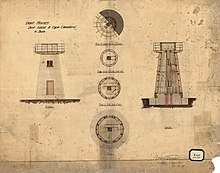Dent Island Light
 Dent Island Lightstation, 2007 | |
 | |
| Location | Dent Island Queensland Australia |
|---|---|
| Coordinates | 20°22′09.31″S148°55′44.17″E/ 20.3692528°S 148.9289361°E |
| Tower | |
| Constructed | 1879 |
| Construction | timber framecladwith galvanized iron |
| Automated | 1987 |
| Height | 33 feet (10 m) |
| Shape | conical tower with balcony and lantern |
| Markings | white tower and lantern, red lantern dome |
| Power source | solar power |
| Operator | Australian Maritime Safety Authority |
| Heritage | listed on the Commonwealth Heritage List |
| Light | |
| Focal height | 121 feet (37 m)[1] |
| Lens | 4th order (original),ML-300(current) |
| Intensity | 1785cd |
| Range | 10 nautical miles (19 km; 12 mi) |
| Characteristic | Fl.W. 5s |
Dent Island Lightis an activelighthouseonDent Island,a small island off the coast ofQueensland,Australia,part of the Whitsunday Group of theWhitsunday Islands.Located on the southwest tip of the island, the light guides ships navigating the Whitsunday Passage, betweenWhitsunday Islandand the islands to the west,[2]and marks the Dent Island Passage.[3]
From its inception, the lighthouse was closely connected toCape Cleveland Light.Both lighthouses were recommended, approved, tendered and finally, in December 1879, constructed together. The light had two upgrades in the 1920s, replacing both the oil lamp and fourth-order lens with anincandescent gas mantleand a new lens. In 1983, it was converted to solar power; and was demanned in 1987.[2]
The lighthouse is a typical for Queensland, made of atimber framecladwithgalvanized ironplates. It is topped by aChance Brotherslantern room, and painted white with a red dome.[2]A modernML-300lantern replaced the original lens.[4]
History
[edit]
From its beginning, the lighthouse was closely related to the Cape Cleveland Light. The construction of both lighthouses was recommended by CommanderGeorge Poynter Heath,the Chairman of the Queensland Marine Board, in February 1878.[2]The lighthouses were formally approved in April 1878 and tenders for the construction of both stations, each including a lighthouse and two keepers' cottages, were called in May 1878 and closed in June 1878.[5]The tenders were awarded to W. P. Clark, who also constructedBustard Head Light(1868),[6]Low Isles Light(1877),[7]Double Island Point Light(1884) andPine Islet Light(1885).[6]However, following personal difficulties,[6]the contracts were transferred to John Clark and James Wiseman who completed the construction of both stations in December 1879.[5]
The tower was constructed in the unique Queensland method of constructing a timber frame and cladding it with non-structural iron plates or iron sheets.[2] The original apparatus comprised a fourth order lens with anoil wick burner[8]of 4,000cdintensity.[2]Like other lighthouses at that time it used aclockworkmechanism with weights, which had to be wound periodically. Due to its short height, only 6 metres (20 ft) from the base to the lantern,[4]the mechanism had to be wound every 75 minutes.[9]
In 1925,[10]the light was upgraded to a 35mmincandescent gas mantlefueled by pressurisedkerosene,with an intensity of 225,000 cd,[11]visible for 18 nautical miles (33 km; 21 mi).[2]In 1927 the lens was replaced with refurbished lens fromCape Cleveland Light.[2]
In 1983[12]the light was converted tosolar powerand downgraded to a visibility range of 10 nautical miles (19 km; 12 mi).[2]It was finally demanned in 1987.[4]
Current display
[edit]The currentlight characteristicis a white flash every five seconds (Fl.W. 5s) visible at 335°-167°, for a distance of 10 nautical miles (19 km; 12 mi).[13] The apparatus is anML-300and the light source is a 12Volt35WattHalogen lampwith an intensity of 1785 cd.[4]

Structures
[edit]The tower is 6 metres (20 ft) from the base to the lantern,[4]conical in shape. It is built of an internal timber frame,cladwithgalvanized ironplates, painted white.[2]Access from the entrance to the lantern is via a circularcast ironstaircase.[2]The tower is topped by a 6 feet 7.75 inches (2.0257 m) diameterChance Brotherslantern room, white painted with the dome painted red.[2]The modernML-300lens is installed inside the lantern room.[14]
The station includes two cottages, constructed in 1960, timber-framed,fibroclad, withgalvanised ironroofs. One of the cottages has two storeys and a closed verandah, while the other is single levelled with an open verandah. The station also comprises a winch house, stores shed, engine room and combined workshop/radio room.[2]
Site operation and visiting
[edit]The light is operated by theAustralian Maritime Safety Authority.The island is accessible only by boat. However, Dent island is privately owned, so the site is closed to the public.[3]
See also
[edit]Notes
[edit]- ^List of LightsandAN362-01.Rowlettlists "37 m (127 ft)" which seems like a unit conversion error.
- ^abcdefghijklmAHD105369.
- ^abRowlett.
- ^abcdeAN362-01.
- ^abQLD601794.
- ^abcAHD100383.
- ^Low Isles Light.
- ^AHD105369.Lighthouses of Australia Incsays it was akeroseneburner.
- ^Lighthouses of Australia Inc.
- ^AHD105369.Lighthouses of Australia Incsays 1926-1927.
- ^AHD105369.Lighthouses of Australia Incsays 50,000 cd.
- ^AN362-01.Lighthouses of Australia Incsays 1981.AHD105369states a conversion to electricity in 1982.
- ^List of Lights
- ^AN362-01.AHD105369says the lens installed on the handrail of the tower balcony, but recent photos show it inside the lantern room.
References
[edit]- List of Lights,Pub. 111:The West Coasts of North and South America (Excluding Continental U.S.A. and Hawaii), Australia, Tasmania, New Zealand, and the Islands of the North and South Pacific Oceans(PDF).List of Lights.United States National Geospatial-Intelligence Agency.2010. p. 202.
- Rowlett, Russ."Lighthouses of Australia: Southern Queensland".The Lighthouse Directory.University of North Carolina at Chapel Hill.Retrieved14 November2010.
- "The Dent Island Lighthouse".Lighthouses of Queensland.Lighthouses of Australia Inc.
- "Dent Island Light, QLD, AN362-01"(PDF).Aids to Navigation Schedule Issue 11.Australian Maritime Safety Authority.September 2004.Archived(PDF)from the original on 28 September 2011.Retrieved8 February2011.
- "Dent Island Lightstation, Dent Island via Hamilton Island, QLD, Australia (Place ID 105369)".Australian Heritage Database.Australian Government.
- "Cape Cleveland Lightstation Precinct, Cape Cleveland via Townsville, QLD, Australia (Place ID 100383)".Australian Heritage Database.Australian Government.
- "Cape Cleveland Lightstation (listing QLD601794)".Australia Heritage Places Inventory.Department of Sustainability, Environment, Water, Population and Communities.
- "The Low Isles Lighthouse".Lighthouses of Queensland.Lighthouses of Australia Inc.
External links
[edit]- Searle, Garry."List of Lighthouses - Queensland".Lighthouses of Australia.SeaSide Lights.

